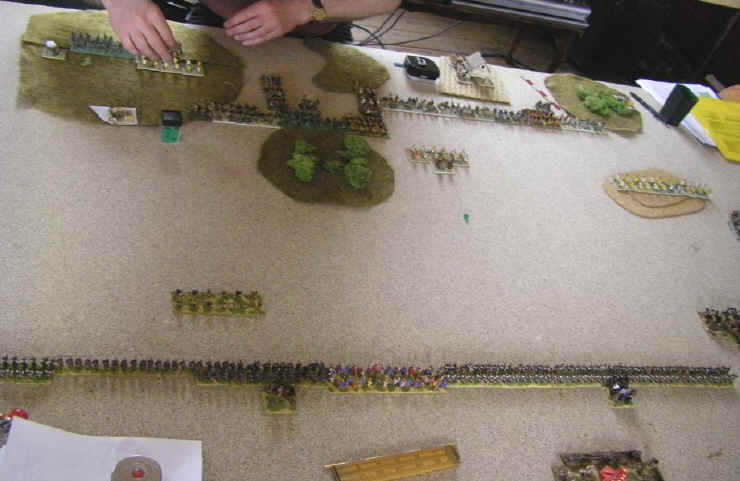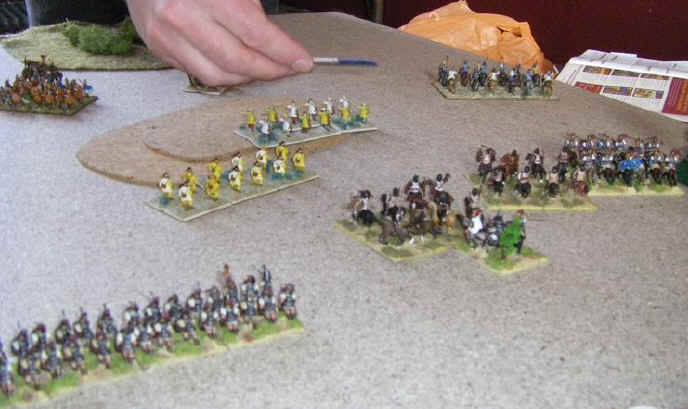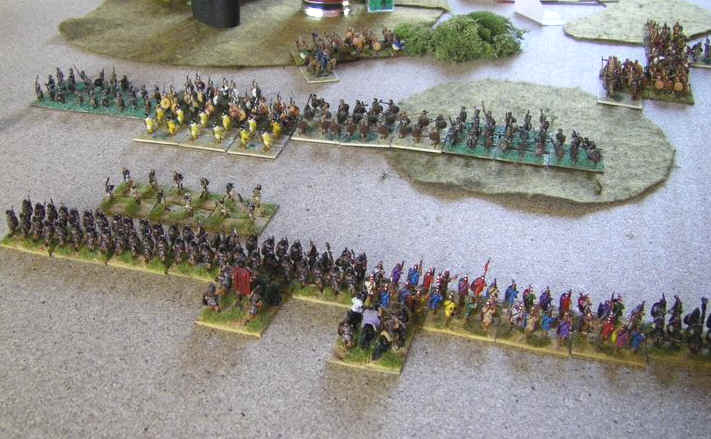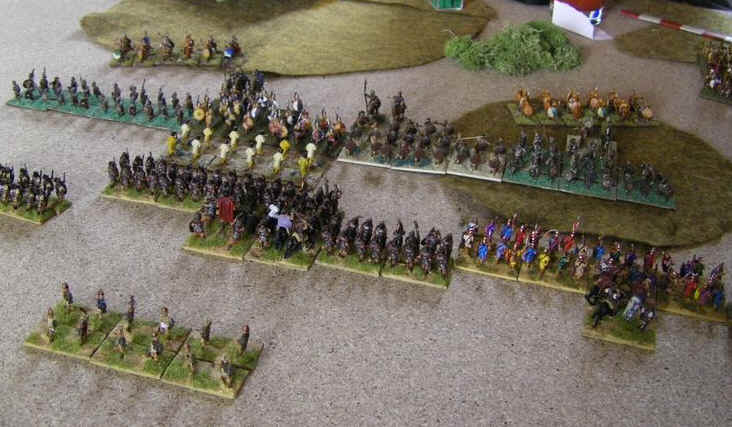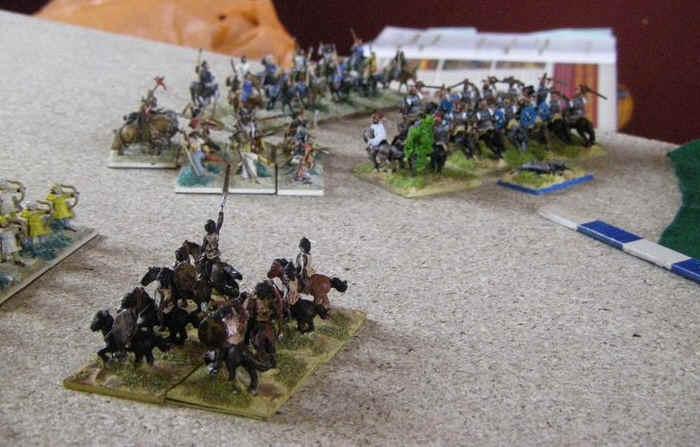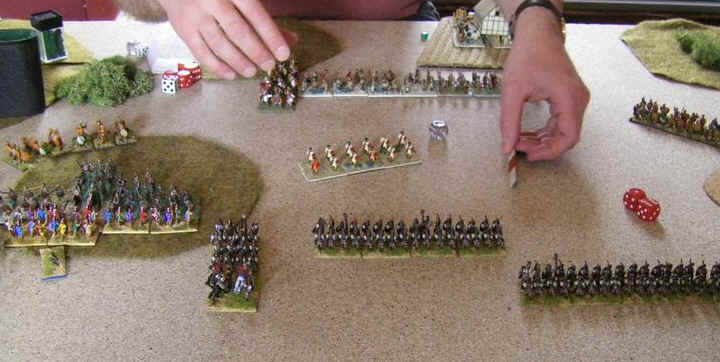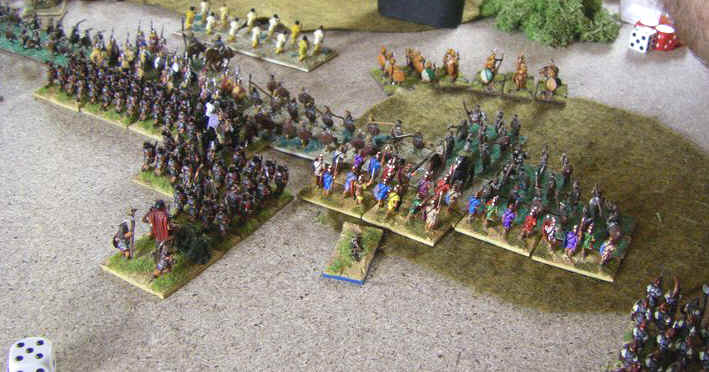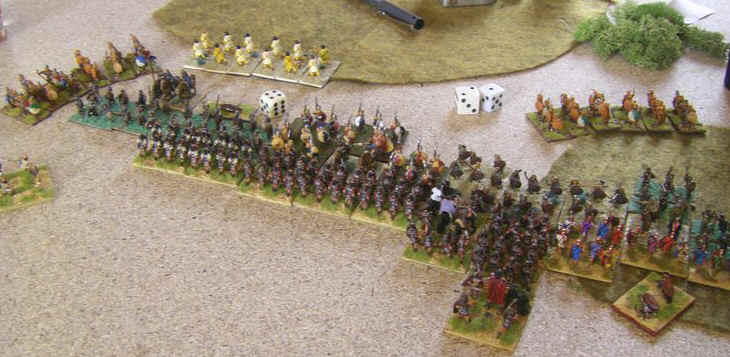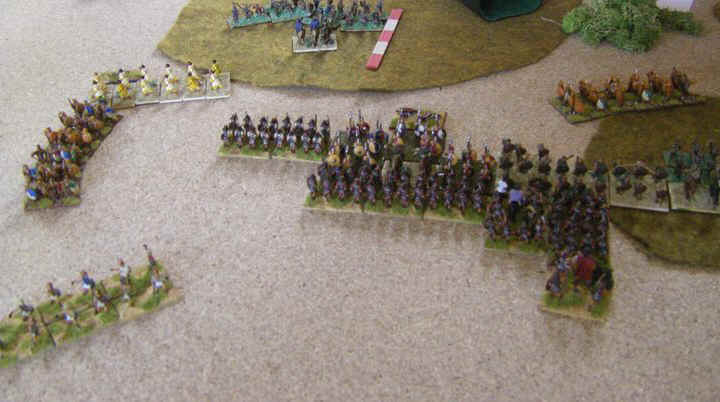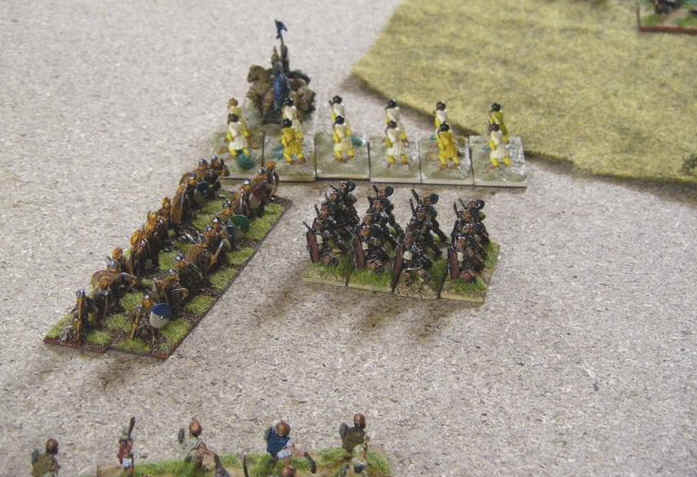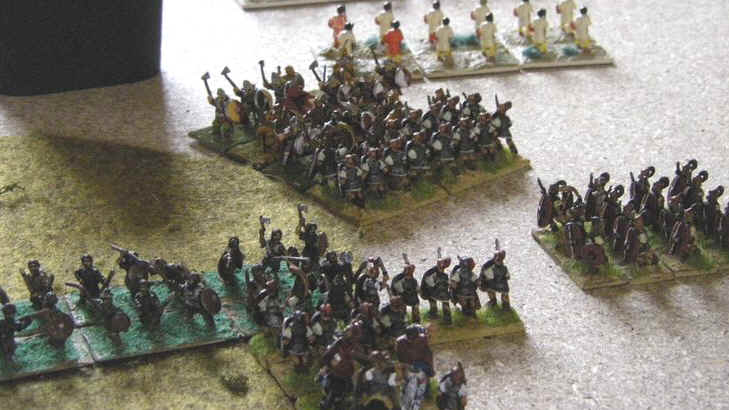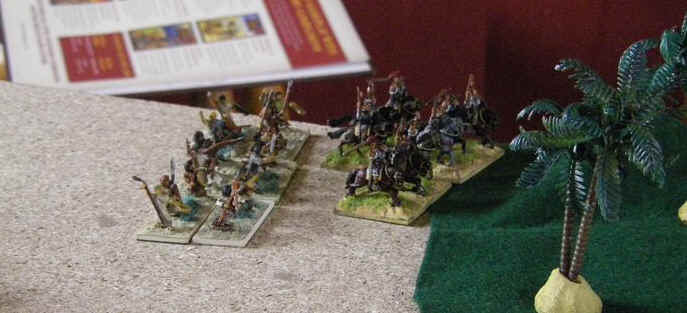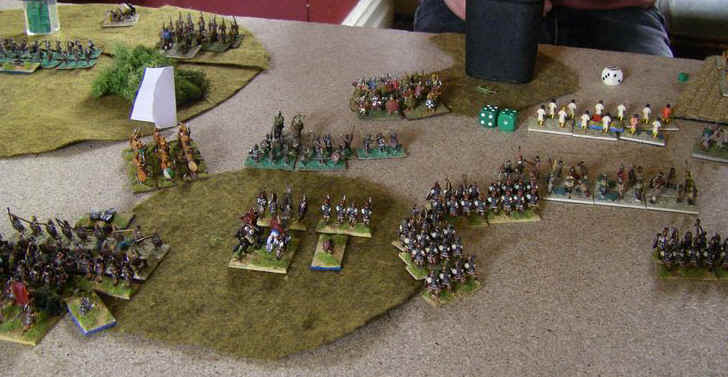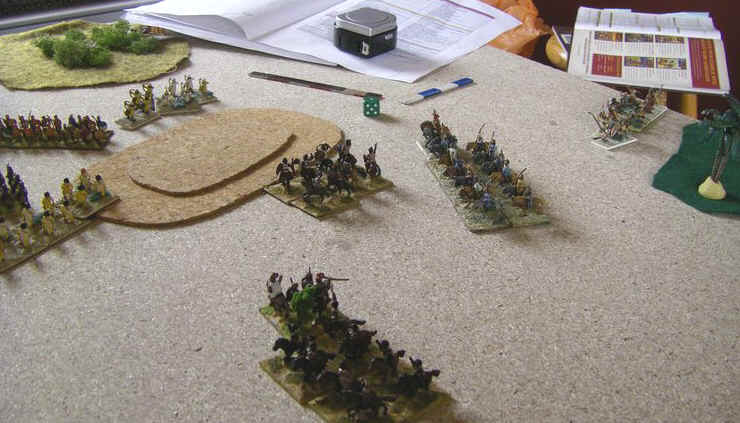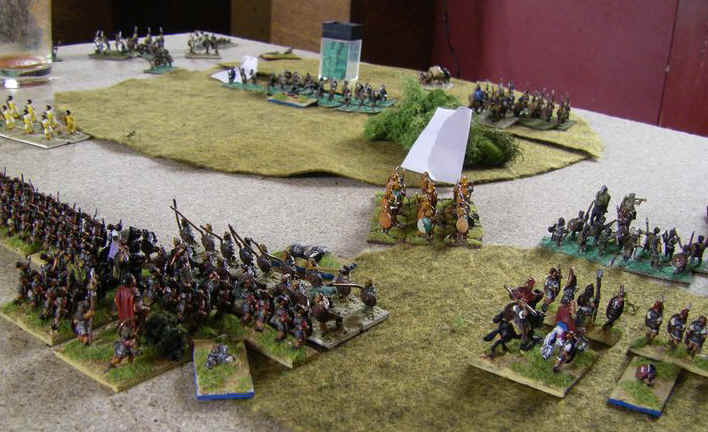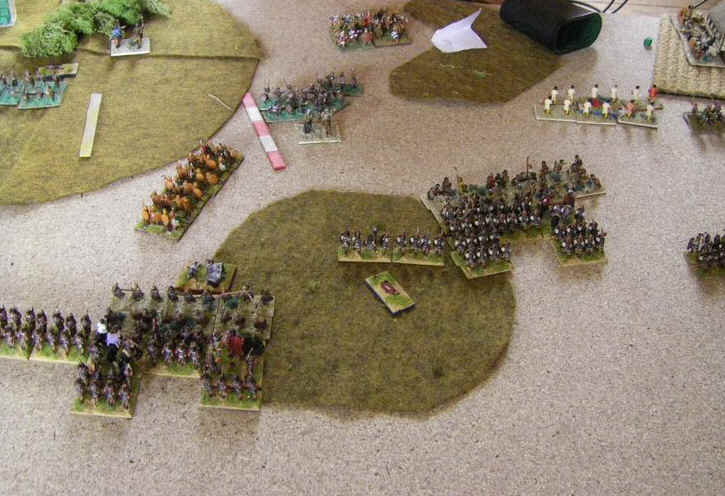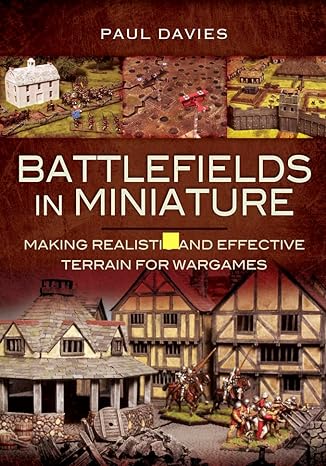Field of Glory Wargaming at The Madaxeman Invitational May 2009
Having organised the odd thing or two in my time, I finally decided it was time to try and organize a small competition. This was partly to tempt a few more players down to the pub where we play, partly to give the landlord some more business (as its rather quiet on a Sunday) and partly as I just fancied a couple of games on a Sunday in a Pub.
The rules were tweaked slightly from the norm, with no modifiers for initiative, and with players being allowed the choice of 2 different 900 AP versions of the same army list - but crucially, with the 600AP starter army having to be used exactly as printed in both of the lists chosen. The basic idea behind all this jiggery-pokery was to hamstring some of the more excessive army compositions, and to give infantry armies more of a chance of getting a decent game against any Steppe Nomads. Also, no 2 players would be allowed to take the same army, for even more variety.
The lists had to be drawn from the Greek & Roman books, so proper wargaming stuff, none of this fancy shooting cavalry rubbish. My choice was a textbook Late Republican Roman list available on my FoG Wiki here.
The theory behind the list was that I owned 40 bases of Old Glory Romans, and I wanted to put them all on the table at the same time. So, not much of the theory, but I knew there was a very-near 100% chance of it working in every game, which would be a serious improvement on my previous attempts to design lists with a plan behind them.
The legions were a mix of Superior and Average, with the average ones mostly in 8's, and the superior in 4's. The starter list meant I had some "compulsory" Illyrian spearmen, and some rather over-kitted out cavalry as well to try and use.
After a slight delay in starting (due to the pub staff still being asleep in bed and not letting us in for about 20 minutes) Game 1 saw me facing .... an Illyrian Army who's list is available here
Pictures of Roman Troops from my Ancients Photo Directory
 |
 |
You can rate the quality of the above figures by clicking on any of the pictures and then clicking on the 5-star voting buttons. Your ratings will be seen by hundreds of other gamers and will help them select the best figures for their armies!
The Illyrians were keen on lurking in terrain, and indeed plenty of rough ground ended up on their side of the table, some of it in fairly forward positions. With the prospect of actually having to fight some of the blighters across the table (rather than shove LH across it in front of me) my army had to deploy mostly in 2 lines, and so was a little short of covering the board. I teed up my own Illyrians to go into the only real bit of rough ground that was that far forward, pushing with legionaries on both sides of them, and sent my 2 units of Numidians and the lone cavalry unit to try and gang up on a block of 6 light horse on away to my right.
The Illyrians were hanging back wherever there was open ground, but had pushed a large number of units forward in the middle ready for a fight.
As the legions advanced, the 2 Numidian units and the Roman Irreg C Heavy Cavalry with JLS & Shield quickly drove off the rather intimidated Illyrian light horse, deployed in a unit of 6 as I think that was mandatory in the 600 AP starter list! This opened up space for some infantry skirmishers to come down from the hills and start taking pot-shots at the Numidians - but with little real oppositions, and a general to help them, they were not unduly worried at this stage.
Over on my left, the line of legionaries was some way short of reaching the table edge, and a colum of Illyrian infantry was slowly moving out to try and take advantage. However the Roman advance was inexorable, and with our own Illyrian infantry happy to take on an evens-fight just to occupy the enemy Illyrians in the rough going, we looked all set to hit most of the enemy advance guard in the open.
With our advantage at impact, I had a half-thought through theory of hitting the Illyrians in successive waves, thus getting as many rounds of impact combat as possible. There also seemed t be a chance of tempting some of the Illyrian units into rash charges out of their solid line, so the Romans duly advanced in a slightly staggered checkerboard (-ish) formation. The Illyrians were however steadfast, and without fail they all failed to charge rashly out of line, and so stood there in line. (eh?)
Back over to the right and the heavy cavalry, scenting a glorious victory, had chased down the Illyrian in one of those "we'll charge along with our Light horse and one of us might catch you" plans - which had failed to catch the Illyrians. The Numidians had driven the skirmishers back onto the safety of the steep hill, but they too were now peppering the Romans with arrows and slingshots. And worst of all, another of the innumerable Illyrian infantry units had wandered over to threaten the Roman cavalry!
With the Romans steadfastly refusing to recover cohesion over multiple turns, it was starting to get hard to extract them from the mess they had somehow gotten themselves into.
Back in the center, battle had been joined, and our Illyrians were refusing to fight well against their fellow countrymen, suffering base losses and cohesion losses at a rapid rate - well, at a rate which looked like they might die long before the Legionaries to their right could get into position to threaten their opponents flanks at any rate. And a vast swathe of the Roman army was still advancing aimlessly across an empty field toward the Illyrian camp.
Despite the Romans advantages at Impact, the Illyrians had actually managed to win pretty much every Impact combat, and steadfastly refused to crumble even on the few occasions they lost the resulting melees. They were fighting like men afraid that the forces of rampant colonial imperialism were about to sweep in and destroy their society and culture!
Wave after wave of Romans charged in, and each time the Illyrians withstood the impact, meaning melee was then at evens. Finally, with the Illyrian mercenaries on the Roman side close to breaking, the Illyrian battle line started to show signs of fatigue as some of their units became disrupted, tipping the tide in favour of Rome as suddenly the Legionaries swords were able to find a way through the enemy wall of spear points! Just as a sneaky Illyrian unit started to creep round the end of the line, the unit they were sneaking past started to waver in its resolve!
The "waver" soon turned into an all-out rout, as the victorious Superior mini-legion blasted forward, leaving the outflanking Illyrian units suddenly isolated and in fear of the damage that might soon be wrought upon them! Even the Roman slingers took heart, as they realised that the Illyrians were in column and so were highly vulnerable to shooting.
The Triumphant Legion (now, that's a good idea....) turned sharply and made its way toward the Illyrians - not unduly worried about being in column, as they could expand to their maximum frontage after impact anyway.
With the Romans Illyrian allies having long since been eliminated, the main strike force of the Legion had managed to make its laborious way across the open ground and was now using the full tactical maneuverability of its many small units to overwhelm the Illyrians piecemeal.
But the Roman Cavalry had also been defeated comprehensively and in detail. Trapped against the edge of the table, they had no answer to an attacking wall of spearmen, and were in full rout.
By now the Romans were slowly chopping their way through wave after wave of Illyrian infantry, but the piratical Illyrians were fighting bravely - and with an immense army the Romans hadn't actually made that much of a dent in the overall force.
Back to the right, and the Illyrian cavalry, freed of their need to occupy the Roman heavies were able to come back into the fray and intimidate the Numidians.
Unbelievably, a unit of Illyrians, hit in maybe the first round of combat of the game, were still fighting - against a now rather tired and battered legion, which needed to be bolstered by the presence of Caesar himself to keep them in line!
The Illyrians had thrown wave after wave of troops into battle, and this had prevented the Romans from pursuing properly - allowing some of the Illyrian units to be rallied by their generals and officers, and so , combined with the Illyrians large army size, and the steadfastness of their men, resulted in time being called with a material, but not decisive victory for Roman might of arms.
Post Match Summary
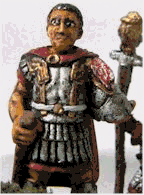 As
Caesar, rightful and legitimate Emperor of all the Romans, descendant of
everyone who kicked Hannibal's A_s, I was fairly comfortable with the progress
of this battle.
As
Caesar, rightful and legitimate Emperor of all the Romans, descendant of
everyone who kicked Hannibal's A_s, I was fairly comfortable with the progress
of this battle.
The pesky enemy Illyrians were where it went wrong - they failed to read the script and managed to survive repeated impact combats all along the line, thus depriving our brave citizen soldiers of their rightful and natural victory which the entrails of the gods own chicken coop had promised up.
The terrain was substantial, but we managed to tough our way through it, tempting the Illyrians into an advance by putting our own Illyrian mercenaries there as a supposedly weak link in our line.
The Patrician cavalry proved yet again that its better to be a legionary in this Mans Army, as the chill winds of republicanism are always there to maybe sweep away the privileges of rank and nobility, as they in fact were by the Illyrian cavalry and spearmen.
But, overall, it wasn't that bad. Quality did tell, our flanks weren't stoved in or outmaneuvered, and we won. What more can you ask for?
Hannibal's Post Match Analysis
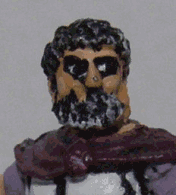 I
waltzed around your puny country for over a decade, smashing any Roman army that
dared come before me, and frankly they were all a lot better than you.
I
waltzed around your puny country for over a decade, smashing any Roman army that
dared come before me, and frankly they were all a lot better than you.
You got away with this - much in the same way you somehow managed to get away with not conceding defeat to Carthage despite having me camped on your lawn, simply by throwing more men at the problem until finally I got bored and went away.
The mistakes you made were legion (ha - did you see what I did there?). Your only Average legionaries were deployed at the end of your line and did all the fighting, when the Superior ones marched across an empty field and barely got hold of anyone. Did you really think the Illyrians would attack you in the open and not in the rough?
Then, frittering away the cavalry on the lame chance that your light horse rolled long? Once the cavalry were past that hill there was no way back for them, so they died where stodd, for no real gain.
Really, you were lucky, and - just like a Roman - you are hoping to write the history afterwards and claim a great victory. But fortunately everyone will be able to read what I say, so go and conjugate that verb Mr Caesar!
Lets hope your next opponent can teach you some declensions.
NEXT!!!
The Ancient Army List Index
The Rise of Rome (280 BC to 25 BC) Mid Republican Roman ; Late Republican Roman ; Gallic ; Pyrrhic ; Later Carthaginian ; Ancient Spanish ; Later Macedonian ; Later Seleucid ; Later Ptolemaic ; Attalid Pergamene ; Numidian or early Moorish ; Pontic ; Early Armenian ; Parthian ; Later Jewish ; Illyrian ; Spartacus Slave Revolt ; Bosporan ;
Storm of Arrows - Western Europe in the Later Middle Ages (1300 AD to 1500 AD) Medieval French ; 100-yrs War English (Continental) ; 100-yrs War English (Britain) ; Later Medieval Scots ( Britain) ; Later Medieval Scots (Continental) ; Later Scots Isles & Highlands ; Medieval Welsh ; Later Anglo-Irish ; Medieval Irish ; Low Countries ; Later Medieval German ; Italian Condotta ; Swiss ; Free Company ; Medieval Burgundian ; Medieval Danish ; Medieval Swedish ; Medieval Castilian ; Medieval Crown of Aragon ; Medieval Portugese ; Later Granadine ; Navarrese ; Ordonnance French ; Wars of the Roses English ; Ordonnance Burgundian ; Santa Hermandad Nueva Castilian
Immortal Fire - The Greek, Persian & Macedonian Wars (550 BC - 146 BC)
Classical Greek ;
Early Achaemenid Persian ;
Lydian ;
Thracian ;
Syracusan ;
Early Carthaginian ;
Skythian or Saka ;
Kyrenean Greek ;
Late Dynastic Egyptian ;
Alexandrian Macedonian ;
Later Achaemenid Persian ;
Classical Indian ;
Early Successor ;
Early Sarmatian ;
Galatian ;
Hellenistic Greek ;
Graeco-Bactrian ;
Graeco-Indian ;
Indo-Greek :
Legions Triumphant - Imperial Rome (25 BC to 493 AD) Dominate Roman ; Principate Roman ; Foederate Roman ; Later Sarmatian ; Early German ; Dacian or Carpi ; Ancient British ; Caledonian ; Early Alan ; Jewish Revolt ; Sassanid Persian ; Kushan or Indo-Skythian ; Palmyran ; Early Frankish, Alamanni, Burgundi, Limigantes, Rugian, Suevi or Turcilingi ; Western Hunnic ; Early Visigothic & Early Vandal ; Early Ostrogothic, Herul, Sciri or Taifali ; Early Anglo-Saxon, Bavarian, Frisian, Old Saxon or Thuringian ; Gepid or Early Lombard ; Early Scots Irish ; Early Pictish ; Hephthalite Hunnic ;
Swords & Scimitars - The Crusades (1096 AD to 1311 AD) Early Crusader ; Later Crusader ; Fatimid Egyptian ; Georgian ; Seljuk Turk ; Cuman ; Komnenan Byzantine ; Post Latin Conquest Byzantine ; Ilkhanid Mongol ; Mamluk Egyptian ; Cilician Armenian ; Syrian States ; Khwarazmian ; Ayyubid Egyptian ; Middle Serbian ; Middle Bulgarian ; Medieval Cypriot ; Latin Greece ; Pecheneg ;
Eternal Empire - Eastern Europe and the Rise of the Ottomans (1300 AD to 1500 AD) Early Ottoman Turkish ; Later Ottoman Turkish ; Tatar ; Later Russian ; Later Serbian Empire ; Later Bulgarian ; Later Lithuanian ; Later Polish ; Later Teutonic Knights ; Catalan Company ; Middle Hungarian ; Moldavian or Wallachian ; Albanian ; Timurid, White Sheep Turcoman or Black Sheep Turcoman ; Later Hungarian ; Hussite ;
Decline & Fall - Byzantium and Islam (493 AD to 1071 AD) Early Byzantine; Maurikian Byzantine ; Thematic Byzantine ; Nikephorian Byzantine ; Later Moorish ; Later Visigothic ; African Vandal ; Italian Ostrogothic ; Early South Slav ; Lombard ; Avar ; Arab Conquest ; Early Bulgar ; Ummayad Arab ; Abbasid Arab ; Early North African Dynasties ; Khurasanian Dynasties ; Bedouin Dynasties ; Dailami Dynasties ; Pecheneg ; Ghaznavid ; Western Turkish (includes Khazar);
Wolves From The Sea - The Hairy European Dark Ages Post Roman British ; Early Welsh ; Later Scots Irish ; Merovingian Frankish ; Later Pictish ; Early Slavic ; Middle Anglo Saxon ; Astur Leonese ; Andalusian ; Early Navarrese ; Carolingian Frankish ; Viking ; Magyar ; Great Moravian ; Early Scots ; Rus ; Norse Irish ; Early Medieval French ; Early Medieval German ; Norman ; Early Polish ; Anglo Danish ;
Swifter Than Eagles - The Biblical Book Nubian ; Early Libyan ; Later Sumerian or Akkadian ; Early Nomad Allies ; Old or Middle Kingdom Egyptian ; Hyksos ; Mitanni ; Syro-Canaanite ; New Kingdom Egyptian ; Later Minoan or Early Mycenaean ; Hittite Empire ; ; Middle or Early Neo-Assyrian ; Later Mycenaean or Trojan ; Sea Peoples ; Philistine ; Phoenician Allies ; Neo-Hittite And Aramaean ; Later Hebrew ; Mannaean Allies ; Libyan Egyptian ; Urartian ; Median ; Neo-Elamite ; Proto-Arab Allies ; Cimmerian or Early Skythian ; Neo-Assyrian Empire ; Phrygian Allies ; Kushite Egyptian ; Neo-Babylonian Empire ;
Oaf of Fealty - Early Medieval Europe Feudal Catalan and Early Crown Of Aragon ; Early Hungarian ; Taifa Andalusian ; Feudal Navarrese and Aragonese ; Feudal Castilian Leonese or Portuguese ; Fanatic Berber ; Italo-Norman ; Feudal French ; Imperial German ; Feudal German ; Communal Italian ; Papal Italian ; Early Scots Isles And Highlands ; Feudal Scots ; Early Russian ; Feudal Polish ; Anglo-Norman ; Later Welsh ; Early Lithuanian or Samogitian ; Wendish Prussian or Estonian ; Early Medieval Frisia and Other Free Cantons ; Post-Viking Scandinavian ; Early Plantagenet English ; Later Sicilian ; Early Medieval Irish ; Early Anglo-Irish ; Early Teutonic Knights ; Mongol Invasion ; Early Granadine ; Middle Plantagenet English ;
Empires of The Dragon - China, Korea and Japan Erlitou-Shang Chinese ; Early Northern Barbarian Allies ; Early Zhou Chinese ; Yayoi Japanese ; Early Horse Nomad ; Ko Choson Korean ; Warring States To Western Han Chinese ; Qiang And Di ; Three Kingdoms Korean ; Eastern Han Chinese? ; Three Kingdoms W Jin And S Dynasties Chinese ; Kofun Nara Japanese ; Northern Dynasties Chinese ; Later Hindu North Indian ; Later Hindu South Indian ; Central Asian City States ; Western Wei To Early Tang Chinese ; ; Later Horse Nomad ; Tibetan ; Nepalese Allies ; Parhae Korean ; Late Tang To Five Dynasties Chinese ; Khmer Or Champa ; Thai Allies ; Nanzhao ; Pyu Burmese Allies ; Koryo Korean ; Early Heian Japanese ; Pagan Burmese ; Liao ; Song Chinese ; Xi Xia ; Ghurid Afghan ; Jin ; Late Heian To Muromachi Japanese ; Japanese Warrior Monk Allies ; Mongol Conquest ; Moslem Indian Sultanates ; Medieval Indonesian Or Malay ; Yuan Chinese ; Medieval Burmese ; Ming Chinese ; Yi Korean
Blood and Gold - The Americas Olmec ; Teotihuacan ; West Mexican ; Zapotec or Mixtec ; Toltec ; Chinantec ; Aztec ; Tarascan ; Tlaxcalan Confederacy ; Mayan ; Mochica ; Chanca ; Chimu ; Hatun-Colla ; Canari ; Inca ; Mapuche or Araucanian ; Amazonian Forest Tribes ; Tupi ; Chichimec ; Pueblo Culture ; Mound-Builder Culture ; South-Eastern Woodland Culture ; Timucuan ; Eastern Woodland Culture ; Plains Culture ; Pacific North-West Culture
View My Stats for My FoG Pages


